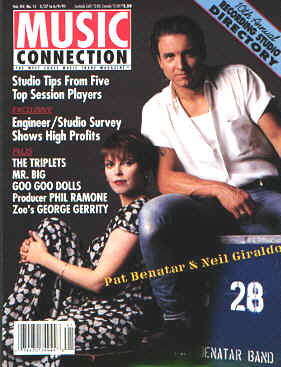
PAT BENATAR: A Former Heartbreaker Finds True Love
-Steven P. Wheeler
Between 1979 and 1988, Pat Benatar was rock's reigning queen, releasing six
platinum and three gold records. during this nine-year span, the fiery vocalist
cracked the Top Forty singles charts no less than fifteen times and dominated the Grammys'
Rock Female Vocalist category with four consecutive wins between 1980 and 1983.
However, after the release of 1988's Top Forty album, Wide Awake In Dreamland, Benatar took a two-year hiatus to raise her daughter, finish building their impressive Malibu residence and immerse herself in various environmentalist causes. She even took up acting with her role in a 1989 ABC Afterschool Special entitled Torn Between Two Fathers.
So what does the harbinger of contemporary female rockers do for an encore? She sheds the rock goddess image, hires a band called Roomful of Blues and makes a genuine blues album.
True Love is her first album in three years and Benatar has achieved a sound that has reignited the artistic fire within one of the most successful female vocalists of the modern era. "I'm thirty-eight-years-old, and I finally feel like I have a grip on my life, on my ability. I just feel like I'm starting out again," the tiny singer says with a hint of a New York accent. "This album has been like a shot that cleans you out and gets your juices flowing again- you're excited and scared at the same time. It's given me all the things that you need to have to be creative."
Things kicked into high gear for the Long Island-born Patricia Andrzejewski when she signed with Chrysalis Records in the late-Seventies. But there was something missing, as she relates the story of how she met her husband Neil Giraldo, who is also his wife's producer and arranger. "When I got my record deal, I told Chrysalis that I wanted a musical partner, not just a guitar player, and they went out and found Neil," laughs Benatar, who adds sarcastically, "obviously, I did get much more than a guitar player." The two were married in 1982 when the top of the charts was still Benatar's home away from home.
While her popularity never really plummeted (her albums have always reached at least golden status) by 1988 Benatar admits that she was getting burnt out on the very things that used to make her happy. "I was really thinking of retiring, because I was just so unhappy. And there's no point in making dead records- because you should be so happy and grateful that you have the opportunity to do this for a living. So when that feeling goes away, it's just not right. I didn't get the feeling onstage that I used to have, and that really bothered me, because it should feel great."
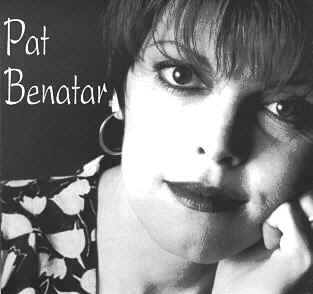 The straw that broke the camel's back occurred during the
recording of Wide Awake In Dreamland. Although the 1988 release featured
the hit single "All Fired Up," for Benatar the magic was gone. "The
three of us- Myron (Grombacher, drummer), Neil and myself- decided that we really couldn't
do another one of those rock records again. We had been doing it for so long, and it
really wasn't feeling the same."
The straw that broke the camel's back occurred during the
recording of Wide Awake In Dreamland. Although the 1988 release featured
the hit single "All Fired Up," for Benatar the magic was gone. "The
three of us- Myron (Grombacher, drummer), Neil and myself- decided that we really couldn't
do another one of those rock records again. We had been doing it for so long, and it
really wasn't feeling the same."
However, time is often the greatest healer, so when it came time to make a new album, the nucleus of the Benatar mystique figured that after a two-year lay-off, they might be able to regain what they had lost. They would soon discover that that was not the case.
It was at this point that Giraldo talked about making a blues album, but he had a difficult time convincing his wife that she could pull it off. "I told him, 'No way,'" the pretty singer with the short hairstyle says with a laugh. "Just because you listen to and love a particular style of music doesn't mean that you have any sort of affinity for it. Rock and blues are obviously connected, but the technique is completely different. The blues is much more subtle; the vocals are a lot more control-oriented and the phrasing is really pulled back compared to singing rock & roll. So there was a bit of a process of trying to figure out whether I could sing this material."
Anyone who has listened to the musical magic of True Love knows that Benatar's initial reservations were unfounded- the classically-trained vocalist has never sung better in her life. Her angelic voice sails effortlessly across a wide spectrum of "jump blues" and gut-wrenching ballads.
In retrospect, Benatar sees this entire experience as one of the biggest gambles of her career. "Once you put away all the fear of trying something new, you get revitalized. If you do something too long, you get locked into it until you can't see anymore. And I don't think I have the personality that can move gradually from one thing to another. This project helped wipe the slate clean, and I feel good about making records again."
Ironically, her record company had no idea what direction the new album would
take until the day they heard the final tapes. "No, they definitely weren't
expecting an album like this," Benatar says with a rebellious gleam in her eye.
"They knew that we wanted to do something different, but they had no idea that
we meant this."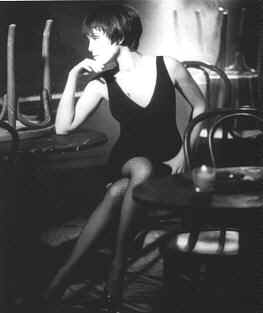
So what was their initial reaction? "It's like they passed out, and we gave them oxygen," she says with a laugh, as she leans back in a chair in the control room of their home studio. "Then they loved it."
The relationship between Benatar and Chrysalis hasn't always been so pleasant, something that the talkative singer has no problem addressing. "It's a different company now, because there's been a big personnel change, and the new people don't pretend to have anything to do with the creative end of things. They're business people, and they know that, which wasn't the case in years gone by."
As for True Love's place in the overall scheme of her career, Benatar doesn't even hesitate. "I love this whole record, and it's a rare thing for me to be satisfied with an entire album of mine. I mean people loved Crimes of Passion (the multi-platinum 1980 release featuring her hit single, "Hit Me With Your Best Shot"), but I just want to scream when people say that, because it was just a bunch of material that didn't work for me, and I wasn't happy with it. People always say it's my best album, and I'm thing to myself, 'Shit, you don't know how good I could have sung on that record.'"
Didn't the platinum success of that album ease the pain? "The success of an album anesthetizes that feeling, but doesn't make it better," she replies with a smile. "I mean, it's still there for all of time for people to hear. I don't' think I can say that I've ever made an album that I'm thrilled with as a whole. That's just the way it is- you're never satisfied, you can't get it all right, so you just go for as much as you can."
Anytime a successful artist breaks away from a proven formula, there is risk of alienating their devoted followers and the radio community. Linda Ronstadt's move from pop/rock to torch songs in the early Eighties is the only notable comparison to what Pat Benatar has done with True Love, something that Benatar says gave her strength when she was unsure of herself. "I didn't consciously look at what Linda did and say, 'If she can do it, I can do it.' But I certainly saw what she had done and saw that it is possible to make a clean break from the past and try something entirely new."
After the decision was made to do a blues album, a lengthy search through Giraldo's comprehensive blues library for material was undertaken. "Neil told me to sit in the room with all this stuff and see if anything stirred my mind. So that's what we did, and it went form 500 to 300 to 250 to 50 until we finally got it down to fifteen songs. I mean, we could do twenty volumes of this stuff."
The other consideration had to do with the fact that a majority of these songs were originally sung by men, so a few lyrical twists and adjustments had to be made accordingly. But Benatar insists that she tried not to listen too hard to the original versions of the songs they ultimately recorded. "I didn't want to start copying vocal licks, because you can't duplicate what they did originally, and to even presume that you could is stupid, so I tried to sing them as if they were my songs."
While a majority of the material included on True Love comes from such legendary figures as B.B. King ("Payin' The Cost to Be The Boss" and "I've Got Papers On You") and Albert King ("I Get Evil"), there are two originals written by Giraldo and Grombacher ("I Feel Lucky" and "The Good Life") and the title track (and first single) written by Benatar and Giraldo.
"It's out of pure admiration and extreme reverence that I made this record," says Benatar about her motivations in undertaking True Love. "This album is a personal thing, but the secondary factor involved with this project is hopefully that people who don't know who Albert King is, are going to check out the rest of his stuff. A lot of people don't know about all these great blues artists who really started it all, which is amazing to me. I mean, it didn't just start with Elvis Presley (laughs)."
As for breaking through the stagnant radio airwaves with this material, Benatar can only cross her fingers and wait. "We had no delusions of this style of music being readily accessible to radio. Sure, you care about those things, but you can't let it stand in front of your original motivations."
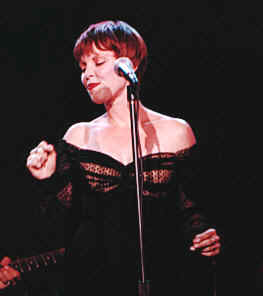 When it comes to the future, Benatar is excited about the upcoming
tour,which will consist of only material from True Love and other blues gems, as
she and Giraldo will be backed by members of Roomful of Blues and Benatar's longtime
keyboardist, Charlie Giordano. But she is non-committal about her future recording
projects.
When it comes to the future, Benatar is excited about the upcoming
tour,which will consist of only material from True Love and other blues gems, as
she and Giraldo will be backed by members of Roomful of Blues and Benatar's longtime
keyboardist, Charlie Giordano. But she is non-committal about her future recording
projects.
"I'm just going to see what happens. Right now, I'm a junkie, and I'm hooked on the blues. It's just a different attitude and a whole other vibe all together." Is age a factor in her musical preference of the moment? "I don't know if the rock thing is awkward for me and others my age, but for me it needs to be augmented, because it's not what it was. If I ever do go back and make albums like I did before, this experience can only make it that much better, because what I've learned on this project in such a short time is amazing."
One of the leading factors in her new outlook on life becomes apparent when Benatar steers the conversation towards motherhood. "When you have a child, your whole perspective is completely changed forever, and that sense of change encompasses everything that you do. It filters into everything that you think and feel. So I started looking at things from another point of view. The main thing is that I don't want to box myself in like I did before."
In her final statement of our interview, Benatar alluded to her past as a theatrical actress in musical comedies, long before she became a rock star, and said: "Looking back on everything, I guess this album was a natural step. Every ten years I seem to try a whole different thing."
![]()
![]()
NEIL GIRALDO: The Man Behind The
Woman
-Steven P. Wheeler
Guitarist/producer/songwriter Neil Giraldo has had as much to do with the success of his wife, Pat Benatar, as the singer herself. As we hiked up a hill located behind their impressive estate and sat down in the dirt overlooking the beautiful and peaceful surroundings, it came as no surprise when the long-haired guitarist looked over the lush green fields below and said, "I consider myself very fortunate. I couldn't be any happier in my life. I love everything about it. I love my family, and I love my music."
The Cleveland-born Giraldo was playing keyboards and guitar with Rick Derringer before he met his future musical partner and wife. "Chrysalis had just signed Pat, and she was looking for a musical director, and they heard about me through Derringer. It's funny, because I was writing songs throughout the time I was with Derringer, but they didn't fit his style. So when Pat and I met, we definitely felt something musically- as well as a personal attraction."
That was almost fifteen years ago, and now one year into the Nineties, Pat Benatar and Neil Giraldo have embarked on a new musical course that has shocked some but delighted countless others. "We've started from scratch," Giraldo says about the duo's drastic change in musical direction. "I just hope people accept it for what it is and not hate it because it's not what we were. We'll have to wait and see."
If the early sales figures are any indication, Giraldo and Benatar won't have
to wait very long. The album has proven that good music will sell, no matter what
the cloning music industry believes. Giraldo says that for the first time in their
career, they had the artistic freedom that they had always asked for, and they made the
most of it. "When we re-negotiated for a new album with Chrysalis, they gave us
more control to do whatever we wanted to do. They told us to make the record that we
wanted to make and to give it to them when it was ready." Giraldo says that a
change in the Chrysalis hierarchy was the leading factor in this new found freedom.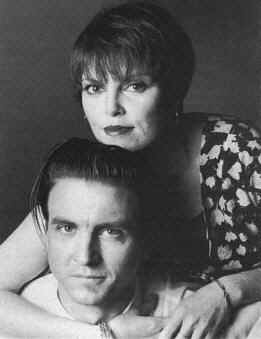
"In the past, they didn't like certain things we did; they wouldn't like the mix on a song or they thought that song was too fast. But I think they've really got some great people in there right now, who understand the concept of artistic freedom. They love this album, which feels great because they had no idea what we had done."
The change of musical direction had as much to do with artistic stagnation as anything else, according to Giraldo. "We were being stylized as something and had become almost like caricatures of ourselves, and we didn't want to fall into that trap. We had a lot of restrains over the past twelve years, which was the main factor in making things difficult to deal with."
Giraldo was the mastermind behind the making of True Love, although he credits his wife with helping shaping the concept of the material. "The original idea for the record that I wanted to make was patterned after an album that Roomful of Blues made with Big Joe Turner about ten years ago. So, in my mind, I kept thinking of that sound, and I finally realized that I might as well get the and that I was thinking about."
However, it took a little coaxing to get the blues veterans of Roomful of Blues to team up with rock & roll duo. "When I originally talked to them, they though I meant we were making a blues/rock album and old me that they weren't right for us. But when I mentioned that I wanted to do some T-Bone Walker songs and things like that, they were convinced."
As a producer, Giraldo says he had to step back a bit from his role as guitarist because he had ten musicians in the studio playing live. "I looked at this project more like a producer, because there are times when I get caught between being the guitarist and the producer and the arranger. When we started this project, I wanted to focus the energy around the whole rhythm of the band, as well as the vocals."
For a producer used to making rock albums, learning how to use a blazing horn section took a little time, but Giraldo's sterling production throughout True Love answers any questions about his prowess as a studio technician. "I've worked with horn sections a little bit in the past, and I had mikes on each individual horn at the outset of this recording. But it only took me twenty-five minutes to realize that it wasn't going to work that way. So I moved them around the room and put a couple of tube mikes up, because I wanted all that live energy to be mixed around."
Giraldo points towards his home studio bellow us, where the entire album was recorded and mixed, and says, "That studio has a very nice room sound to it, and the close miking was choking the overall sound of everything. I wanted that 'air' around everybody, but once everybody gets in the studio, the sound gets soaked up a little bit, which in retrospect was good, otherwise it would have been like being in a reverb tent."
The actual recording process went very quickly- all the tracks were laid down in two weeks, and the mix was taken care of soon afterwards. A rapid speed that Giraldo credits to the personalities involved. "It might sound like jive, but there's a real family feeling among the people who played on this album. It's that family thing that makes great takes and keeps things rolling. It was boom, boom, boom, one right after the other, and I think that feeling comes across because I think it has a very happy feeling to it. Even though it's the blues, I think it makes you feel good." Judging by the soaring sales of True Love, there are quite a few music fans feeling good now.
![]()
![]()